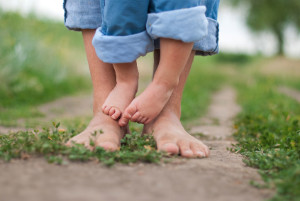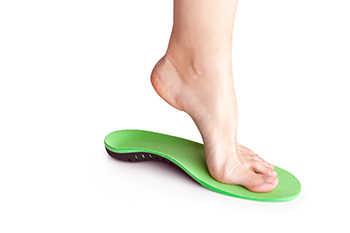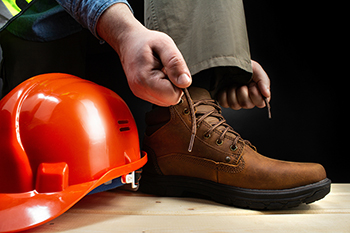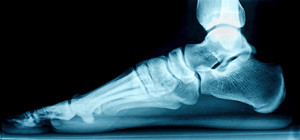Items filtered by date: November 2023
Rocker Bottom Foot in Newborns

Vertical talus, often known as a rocker bottom foot, is a rare congenital condition in children where the talus bone, a key ankle component, points towards the ground instead of the toes. This misalignment leads to a stiff foot without an arch. It can occur alone or be associated with other health conditions. Diagnosis typically occurs at birth or through prenatal ultrasound. A podiatrist can assess flexibility and rigidity, using X-rays to determine the severity of misalignment. Oblique talus, a milder form of rocker bottom foot, shows misalignment only during weight-bearing. Treatment is aimed at reducing pain, advancing stability, and creating a functional foot. Non-surgical options, such as stretching or casting, may precede surgery. A series of casts can gradually improve foot flexibility. If surgery is needed, it corrects bone positions, potentially involving tendon or ligament lengthening. Post-surgery, casts, and pins are used to maintain corrections. Special shoes or braces may prevent recurrence. Understanding rocker bottom foot deformities is important for early detection and effective treatment. With a combination of non-surgical and surgical approaches, podiatrists aim to ensure pain-free, stable, and functional feet for optimal childhood development. Regular follow-up visits can help to monitor growth and address issues promptly. It is suggested that you make an appointment with a podiatrist to discuss the treatment schedule for your child.
Congenital foot problems require immediate attention to avoid future complications. If you have any concerns, contact one of our podiatrists of Toe-tal Family Footcare Associates. Our doctors can provide the care you need to keep you pain-free and on your feet.
Congenital foot problems are deformities affecting the feet, toes, and/or ankles that children are born with. Some of these conditions have a genetic cause while others just happen. Some specific foot ailments that children may be born with include clubfeet, polydactyly/macrodactyly, and cleft foot. There are several other foot anomalies that can occur congenitally. What all of these conditions have in common is that a child may experience difficulty walking or performing everyday activities, as well as trouble finding footwear that fits their foot deformity. Some of these conditions are more serious than others. Consulting with a podiatrist as early as possible will help in properly diagnosing a child’s foot condition while getting the necessary treatment underway.
What are Causes of Congenital Foot Problem?
A congenital foot problem is one that happens to a child at birth. These conditions can be caused by a genetic predisposition, developmental or positional abnormalities during gestation, or with no known cause.
What are Symptoms of Congenital Foot Problems?
Symptoms vary by the congenital condition. Symptoms may consist of the following:
- Clubfoot, where tendons are shortened, bones are shaped differently, and the Achilles tendon is tight, causing the foot to point in and down. It is also possible for the soles of the feet to face each other.
- Polydactyly, which usually consists of a nubbin or small lump of tissue without a bone, a toe that is partially formed but has no joints, or an extra toe.
- Vertical talus, where the talus bone forms in the wrong position causing other bones in the foot to line up improperly, the front of the foot to point up, and the bottom of the foot to stiffen, with no arch, and to curve out.
- Tarsal coalition, when there is an abnormal connection of two or more bones in the foot leading to severe, rigid flatfoot.
- Cleft foot, where there are missing toes, a V-shaped cleft, and other anatomical differences.
- Macrodactyly, when the toes are abnormally large due to overgrowth of the underlying bone or soft tissue.
Treatment and Prevention
While there is nothing one can do to prevent congenital foot problems, raising awareness and receiving neonatal screenings are important. Early detection by taking your child to a podiatrist leads to the best outcome possible.
If you have any questions please feel free to contact our office located in Vista, CA and Las Vegas, NV . We offer the newest diagnostic tools and technology to treat your foot and ankle needs.
Orthotics for Plantar Fasciitis

Managing plantar fasciitis can make mornings difficult, as stepping out of bed often brings heel pain. This common condition causes discomfort in the heel or foot arch, hindering activities such as exercising and walking. Plantar fasciitis stems from various causes, including excessive exercise, repetitive motion, or from wearing ill-fitting footwear Additionally, conditions that can include high arches, flat feet, weight gain, diabetes, and arthritis may also lead to developing this condition. These factors can lead to inflammation in the plantar fascia. Custom-made orthotics, tailored to your foot's biomechanics and gait, can be an effective treatment. These devices, fitted in your shoes, can aid in recovery from stress or tears and mitigate movements causing inflammation. If you suffer from persistent plantar fasciitis pain, it is suggested that you make an appointment with a podiatrist who can design orthotics for you to help manage your heel pain.
If you are having discomfort in your feet and would like to try orthotics, contact one of our podiatrists from Toe-tal Family Footcare Associates. Our doctors can provide the care you need to keep you pain-free and on your feet.
What Are Orthotics?
Orthotics are inserts you can place into your shoes to help with a variety of foot problems such as flat feet or foot pain. Orthotics provide relief and comfort for minor foot and heel pain but can’t correct serious biomechanical problems in your feet.
Over-the-Counter Inserts
Orthotics come in a wide variety of over-the-counter inserts that are used to treat foot pain, heel pain, and minor problems. For example, arch supports can be inserted into your shoes to help correct overarched or flat feet, while gel insoles are often used because they provide comfort and relief from foot and heel pain by alleviating pressure.
Prescription Orthotics
If over-the-counter inserts don’t work for you or if you have a more severe foot concern, it is possible to have your podiatrist prescribe custom orthotics. These high-quality inserts are designed to treat problems such as abnormal motion, plantar fasciitis, and severe forms of heel pain. They can even be used to help patients suffering from diabetes by treating foot ulcers and painful calluses and are usually molded to your feet individually, which allows them to provide full support and comfort.
If you are experiencing minor to severe foot or heel pain, it’s recommended to speak with your podiatrist about the possibilities of using orthotics. A podiatrist can determine which type of orthotic is right for you and allow you to take the first steps towards being pain-free.
If you have any questions please contact our office located in Vista, CA and Las Vegas, NV . We offer the newest diagnostic and treatment technologies for all your foot and ankle needs.
Preventing Common Workplace Foot Injuries

Workplace foot injuries are not only painful but can also lead to lost productivity and reduced quality of life. To avoid such mishaps, consider these essential strategies. First and foremost, wearing proper footwear is key. Invest in sturdy, comfortable shoes or boots designed for your specific work environment. Ensure they fit well and provide ample support. Second, keep your workspace clutter-free. Remove any obstacles or tripping hazards that could lead to slips and falls. Next, practice good housekeeping, ensuring spilled liquids are cleaned promptly. Additionally, stay mindful of the ergonomic design of your workspace, which can reduce the strain on your feet. Last but not least, if your job involves heavy lifting or dangerous machinery, always use the provided safety gear. This can include wearing steel-toed boots and foot guards to protect against falling objects or potential crushing accidents. By staying vigilant and following these guidelines, you can significantly reduce the risk of common foot injuries in the workplace and keep your feet in top condition. If you would like information about appropriate shoes to wear for work, it is suggested that you visit a podiatrist.
While working on the feet, it is important to take the proper care of them. For more information about working on your feet, contact one of our podiatrists from Toe-tal Family Footcare Associates. Our doctors will treat your foot and ankle needs.
Working on Your Feet
Standing on your feet for long periods of time can cause stress and pain in your feet. Your whole body may experience change in terms of posture, back pain, bunions, callouses and or plantar warts. There are ways to avoid these conditions with proper foot care, smart choices and correct posture.
Positive Changes
Negative heeled shoe – Choosing this shoe type places the heel slightly lower than the ball of the foot. These are great for overall foot health. Find shoes that fit you correctly.
Go barefoot – Our feet were not designed to be enclosed for all hours of the day. Try to periodically expose your feet to air.
Eliminate Pain
Foot Exercises – Performing simple exercises, incorporating yoga and doing stretches are beneficial. This will allow increased blood flow to the area and muscles of the foot.
Achilles tendon – Stretching the foot out flat on the floor will relax the calf muscles and tendon. These exercises can be performed almost anywhere. Make sure you add these exercises to your daily regimen.
With a little bit of this information and knowing more about foot health, you will notice changes. Foot stretches and proper footwear will help with pain and prevent further issues.
If you have any questions please feel free to contact our office located in Vista, CA and Las Vegas, NV . We offer the newest diagnostic and treatment technologies for all your foot and ankle needs.
Understanding the Progression of Flat Feet in Adults

Flat feet, a common condition in adults, occurs when the arches of the feet collapse, causing the entire sole to touch the ground. This condition typically advances through several stages, each with its own set of symptoms. In the early stages, some individuals may not experience any discomfort or issues, while others may feel mild pain or fatigue after prolonged standing or physical activity. As flat feet progress, the discomfort can intensify, spreading to the ankles, knees, and lower back. This can result in reduced mobility and chronic pain. In severe cases, the arch completely flattens, and the foot loses flexibility, leading to a more pronounced disability. Recognizing the stages of flat feet is important for appropriate management, as early intervention can bring various choices of treatment to choose from. If you have flat feet, it is suggested that you are under the care of a podiatrist who can guide you toward appropriate relief methods.
Flatfoot is a condition many people suffer from. If you have flat feet, contact one of our podiatrists from Toe-tal Family Footcare Associates. Our doctors will treat your foot and ankle needs.
What Are Flat Feet?
Flatfoot is a condition in which the arch of the foot is depressed and the sole of the foot is almost completely in contact with the ground. About 20-30% of the population generally has flat feet because their arches never formed during growth.
Conditions & Problems:
Having flat feet makes it difficult to run or walk because of the stress placed on the ankles.
Alignment – The general alignment of your legs can be disrupted, because the ankles move inward which can cause major discomfort.
Knees – If you have complications with your knees, flat feet can be a contributor to arthritis in that area.
Symptoms
- Pain around the heel or arch area
- Trouble standing on the tip toe
- Swelling around the inside of the ankle
- Flat look to one or both feet
- Having your shoes feel uneven when worn
Treatment
If you are experiencing pain and stress on the foot you may weaken the posterior tibial tendon, which runs around the inside of the ankle.
If you have any questions please feel free to contact our office located in Vista, CA and Las Vegas, NV . We offer the newest diagnostic and treatment technologies for all your foot and ankle needs.
